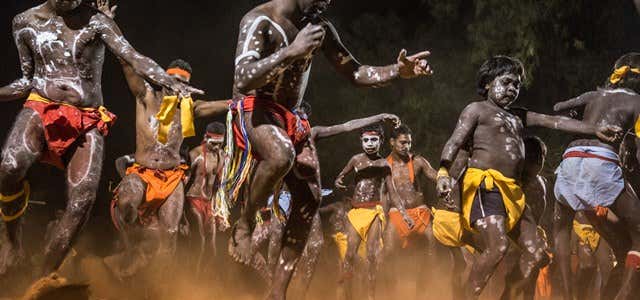Stretching back over 50,000 years, Indigenous Australia’s culture is the oldest living culture on Earth and as custodians of the land, Aboriginal Australians stories describe the birth of the continent itself.
A deeply spiritual culture, their stories are based on the concept of The Dreaming. The shape-shifting ancestral Dreaming spirits could morph into many forms, from animals to people, (or in fact any physical thing) and were able to carve the contours of the landscape, create religious and values systems for Indigenous Australians and populate the land with both people and animals as they moved across the continent.
Once the world was established the Dreaming spirits then reinvented themselves as the gorges, hills and wetlands that are Australia, constantly reminding Indigenous Australians of their presence. And from a more fundamental perspective the Dreaming stories educated the people on important aspects of the landscape such as where to find water, where to find places laden with food and where to locate other indigenous tribes.
Take a trip around Western Australia and you will uncover some of the oldest collections of rock art in the world and learn about a rich culture that has been around for tens of thousands of years and whose people lived in harmony with nature, sourcing food, shelter, medicine and surviving in the wonderful, yet harsh climate that typifies WA.
A land of vast gorges and infinte skies, the Kimberley is one of the worlds precious and dwindling great wildernesses. And in this glorious landscape lies a cache of amazing Indigenous art, from petroglyphs in the Burrup Peninsula to Gyorn Gyorn (some of the oldest art works), Gwion Gwion Bradshaw figures and Wandjina rock art. Viewing these ancient works is made all the more special as you wander the landscape where they were created and where the artists themselves lived.
The Worrora, Ngarinyin and Wunumbai tribes of the Kimberley believe the Wandjina is the supreme spirit whereas other Australian Aboriginal tribes believe the Dreamtime snake or Rainbow serpent was the Creator Ancestor.
Wandjina art, is over 3,000 years old and illustrates the Creator Ancestors who control the lightening storms that bring in the wet season. These ancestors have large eyes, pointed noses but no mouths and their heads are crowned with lightning strikes.
In contrast, the thin, elegant Gwion Gwion figures are at least 17,000 years old. These are painted in hematite ochre that has merged with the rock surface and the art now looks ingrained into the rock itself.
You can check galleries of both styles if you pop your walking shoes on and walk to Mitchell Falls (which is worth doing regardless). There are two shelters at the falls (that sadly aren’t signposted). The Gwion Gwion figures are positioned high up and the Wandjina figures sit lower down. And if you venture a little further, beneath the veil of Little Merton Falls, you’ll be rewarded with a gallery of animal paintings.
1
Mowanjum Art and Culture Centre
However, if venturing into the wilderness isn’t your thing, or you are short on time, the three tribes of the Mowanjum Community (The Worrora, Ngarinyin and Wunumbai tribes) established the Mowanjum Art and Cultural Centre (located just out of Derby) which showcases Wandjina and Gyorn Gyorn figures based on the rock paintings central to their culture. You can also see artifacts, there’s a replica Wandjina cave and a shop where you can purchase carved boab nuts and pearl shell jewellery.
2
Waringarri Art Gallery
Another option is to take a tour run by Waringarri Arts, with an artist or arts worker. You will see the artists at work and learn about the history of the center whilst munching on home made damper.
Or they can organise for you to visit the Waingarris public art sites with an Indigenous guide and learn about Miriwoong culture and art, before being entertained by a digeridoo performance and sharing bush foods and damper.
One of 12 UNESCO Natural World Heritage Sites in Australia, Purnululu National Park covers an enormous 240,000 hectares of wilderness which includes the newly discovered (relatively) Bungle Bungle Range. Whilst being around for about 350 million years, and being revered by it’s Aboriginal custodians for about 40,000 years, The Bungle Bungle was only known to local Aboriginal owners and farmers until a documentary team brought the orange and black sandstone beehive shaped domes to the world in 1983. Set amongst yawning gorges and pools fringed with rare palm trees, the Bungle Bungle Range is truly a sight to be seen.
Wander this spectacular landscape with Bungle Bungle Guided Tours who will share an Aboriginal perspective of these sculpted rocks and sandstone towers. Go back in time 40,000 years and hear the stories of the people of this area, about their customs as well as the cultural significance and reasons behind this ancient place being awarded World Heritate list status.
Another tour they offer, which does require a reasonable level of fitness, will take you around the Bungle Bungle and into Cathedral Gorge where the cavernous cliffs open up to create a natural acoustic marvel. Then continue wandering along the sandy shores of Piccaninny Creek, which only flows in the rainy monsoon season. The Aboriginal guides will introduce you to the uniqe flora and fauna and the six seasons of this land before you climb the rocky path into Echidna Chasm which narrows to a mere two foot gap to squeeze through.
4
Burrup Peninsula
Heading in a westerly direction you will come to the Pilbarra. With over 700 sites of Indigenous rock engravings, many dating back 20,000 years, the Burrup Peninsula of the Pilbara is now listed as one of the World Monument Funds 100 Most Endangered Places in the World.
Also known as Murujuga, the Burrup has one of the worlds largest collections of rock carvings (or petroglyphs).
5
Fern Pool
Like Murujuga, Karijini has enormous significance for the local Aboriginal people. One of the more important places to visit is the beautiful Fern Pool - known as Jubara – which is a womens place. At one end of Dales Gorge, it’s here in Jubara that the Dreamtime Creation Serpent lived after travelling through the Pilbara creating all of the rivers, lakes and streams of the area.
6
Mount Bruce
Punurrunha (or Mt Bruce) situated near the mining town of Tom Price, is the states second highest mountain. This is a special place for men. So much so that indigenous women, raised in the traditional ways, will not even look at it as they pass by.
The capital of the State, Perth, luxuriates on the coast and is the launch or landing pad for many a WA adventure. So to finish our guide to a few indigenous highlights of Western Australia head to the vast open spaces of Australias Wheatbelt, on the Albany Highway, to The Kodja Place. The gallery features Noongar paintings, boomerangs, digerdoos and hand-painted pottery.
Based on ‘One Story, Many Voices” the Kodja Place also tells the story of life in a south western farming community, including traditional Noongar story telling. Depicting life on the reserve, stories of early settlers and the experience of farmers, you can follow three women – Yoondi the Noongar, Elizabeth the English settler and Maria and Italian immigrant - and understand the complexity of the weave that comprises modern Australia.
This is all built around the Kodja, a Noongar stone axe after which the centre is named.
Aboriginal Art Gallery
Ending up in Perth is always exciting, it’s busy hustle and bustle, glorious harbour and beaches, let alone all of galleries and restaurants that have sprung up in Perth over the past decade make Perth a sophisticated destination in it's own right. And even in the centre of this busy metropolis you can satisfy your quest to see Aboriginal art.
Located in Kings Park and overlooking the Swan River the Aboriginal Art Gallery was built as an exhibition space for Western Australian Indigenous artists. Whilst they showcase a variety of contemporary and traditional Aboriginal art and artefacts, you can meet and chat with the artists as well as watch them work on their craft. You will also get the opportunity to listen to and see their stories expressed in music and in dance, performed by some Australia’s leading Aboriginal artists. A great end to an big trip exploring the enduring expression of Western Australias Aboriginal people.
Explore More Trip Guides
Discover the wonders of Indigenous South Australia
- 13 Places
- 27:03
- 1,354 mi
NSW Indigenous Art and Culture
- 11 Places
- 27:44
- 1,468 mi
Exploring Indigenous Australia - Northern Territory
- 13 Places
- 18:60
- 1,085 mi
A Highway 1 road trip along California’s Central Coast
- 14 Places
- 02:49
- 99 mi











